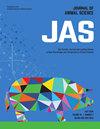Differences in severity of reticulo-rumen pH drop in primiparous Holstein cows fed the same diet during transition and early lactation: effects on performance, energy balance, blood metabolites, and reproduction
IF 2.9
2区 农林科学
Q1 AGRICULTURE, DAIRY & ANIMAL SCIENCE
引用次数: 0
Abstract
We recently reported factors leading to different severity of ruminal pH drop in primiparous cows fed the same diet during transition and early lactation. The present study evaluates the effects of those severities on performance and several blood and balance parameters in the same 24 primiparous cows from 3 wk before calving until wk 10 in lactation. Dietary concentrate was increased for all cows from 32 before calving to 60% (DM basis) over the first wk in lactation, resulting in a diet with 40% non-fiber carbohydrates (NFC), and 14.4% physically effective fiber (peNDF>8). Ruminal pH was monitored with indwelling systems in all cows during the study; then several indices of duration and magnitude of pH change were used as indicators of the severity of ruminal pH drop. Accordingly, as reported in the companion paper, the cows were classified as either higher pH drop (HIGH; n = 9), moderate (MOD; n = 9) and lower (LOW; n = 6) severity of pH drop. In the present report, body weight, body condition score, and back fat thickness decreased but rumen mucosa thickness increased after calving in all cows (P < 0.05). Post-partum daily energy intake in HIGH was greater (P < 0.05) than the other categories. In addition, there were 5.6 kg extra of energy-corrected milk in HIGH (P < 0.05). Independent of severity of pH drop, blood glucose, non-esterified fatty acids, beta-hydroxybutyrate, bilirubin and cortisol were higher, whereas triglycerides, total protein, globulin, albumin, urea nitrogen, cholesterol, calcium and phosphorous were lower at calving (P < 0.05). Blood cholesterol was greater in HIGH than the other pH categories (P < 0.05); insulin and reproductive variables were not affected by severity of pH drop. Overall, primiparous cows fed the same diet showed different severity of ruminal pH drop, but the individual variation in ruminal pH depression was not related to a negative impact on milk yield, energy balance or blood metabolites during the study. This indicates that the impact of low ruminal pH on the animals may depend not only on severity of the pH drop (average of 403 min/d of pH<5.8 over 13 wk) but also on diet characteristics. Specifically, drops of ruminal pH can be tolerated by primiparous cows during the first 10 wk in milk consuming a diet containing 40% NFC and 14.4% peNDF>8. It would be worth studying the severity of ruminal pH drop in a larger sample size during the entire lactation and if the severity is sustained on the next lactation.在过渡期和泌乳早期,饲喂相同饲粮的初产荷斯坦奶牛网状瘤胃pH下降程度的差异:对生产性能、能量平衡、血液代谢产物和繁殖的影响
我们最近报道了在过渡期和泌乳早期饲喂相同饲粮的初产奶牛,导致不同程度的瘤胃pH下降的因素。本研究评估了这些严重程度对24头奶牛产犊前3周至泌乳第10周的生产性能和若干血液和平衡参数的影响。在泌乳期第一周,将所有奶牛的饲粮精料从产犊前的32%增加到60% (DM基础),使日粮中非纤维碳水化合物(NFC)含量为40%,物理有效纤维含量为14.4% (peNDF>8)。在研究期间,采用留置系统监测所有奶牛的瘤胃pH;然后以pH变化的持续时间和幅度作为衡量瘤胃pH下降严重程度的指标。因此,正如论文中所报道的那样,奶牛被分类为pH值下降较高(HIGH;n = 9),适度(MOD;n = 9)和更低(LOW;n = 6) pH下降的严重程度。在本报告中,所有奶牛产犊后体重、体况评分和背部脂肪厚度均下降,但瘤胃黏膜厚度增加(P <;0.05)。产后每日能量摄入较高(P <;0.05)高于其他类别。此外,HIGH (P <;0.05)。与pH下降的严重程度无关,产犊时血糖、非酯化脂肪酸、β -羟基丁酸、胆红素和皮质醇较高,而甘油三酯、总蛋白、球蛋白、白蛋白、尿素氮、胆固醇、钙和磷较低(P <;0.05)。高pH组的血胆固醇高于其他pH组(P <;0.05);胰岛素和生殖变量不受pH下降严重程度的影响。总体而言,饲喂相同饲粮的奶牛瘤胃pH下降程度不同,但瘤胃pH下降的个体差异与研究期间产奶量、能量平衡或血液代谢物的负面影响无关。这表明,低瘤胃pH值对动物的影响可能不仅取决于pH值下降的严重程度(13周内平均为403 min/d),还取决于日粮特性。具体而言,在饲粮中添加40% NFC和14.4% pendf的情况下,初产奶牛在头10周内可以耐受瘤胃pH的下降。在整个泌乳过程中,在更大的样本量中研究瘤胃pH下降的严重程度,以及这种严重程度是否在下一次泌乳中持续下去,是值得研究的。
本文章由计算机程序翻译,如有差异,请以英文原文为准。
求助全文
约1分钟内获得全文
求助全文
来源期刊

Journal of animal science
农林科学-奶制品与动物科学
CiteScore
4.80
自引率
12.10%
发文量
1589
审稿时长
3 months
期刊介绍:
The Journal of Animal Science (JAS) is the premier journal for animal science and serves as the leading source of new knowledge and perspective in this area. JAS publishes more than 500 fully reviewed research articles, invited reviews, technical notes, and letters to the editor each year.
Articles published in JAS encompass a broad range of research topics in animal production and fundamental aspects of genetics, nutrition, physiology, and preparation and utilization of animal products. Articles typically report research with beef cattle, companion animals, goats, horses, pigs, and sheep; however, studies involving other farm animals, aquatic and wildlife species, and laboratory animal species that address fundamental questions related to livestock and companion animal biology will be considered for publication.
 求助内容:
求助内容: 应助结果提醒方式:
应助结果提醒方式:


